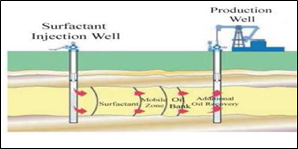Surfactant-Polymer Slug Optimization, Injection Rate & Pattern Size Determination Using The Cmg Simulator In The Mj Well
DOI:
https://doi.org/10.25299/jgeet.2024.9.3.19206Keywords:
Surfactant -Polymer, Injection Rate, Slug, Pattern, EORAbstract
The MJ well is one of the oldest in the Central Sumatra field. This field was originally produced in 1952, with a reserve of 4.5 MMSTB. This explains why EOR studies are needed to increase the production of oil.
The MJ well can be injected with surfactant-polymer based on the EOR screening criteria. Surfactant performance mechanisms can minimise IFT and displacement, however, polymers can limit mobility by increasing the viscosity of formation water and sweep efficiency. It is preferable to use reservoir modelling before applying surfactant-polymer to a well. Surfactant-polymer simulation, specifically CMG software, is used in this research. Several simulations were run using sensitivity such as slug SP, injection rate, and pattern size to determine the best approach for use in the MJ well. Surfactant injection was performed after a year of applying a water flood followed by injection of surfactant-polymer with several slug variations, namely 0.2 PV, 0.3 PV, 0.4 PV, 0.5 PV, and 0.6 PV at varied injection rates. 1600 BPD, 2300 BPD, and 3000 BPD, as well as many well-pattern variations, including a 5-spot pattern, a 7-spot pattern, and a 9-spot pattern.
Based on the simulation, optimal results are obtained at a slug of 0.6 PV, an injection rate of 3000 BPD, and a 5-Spot well pattern with a total amount of oil of 2,023,700 bbl and a recovery factor of 81.67%.
Downloads
References
Abdelsadeg, N., Alhebshy, A. A., Muftah, A., & Almabrouk, M. A. (2017). CO 2miscibleflooding forAswad Oil Field,3, 101–111.
AbuElEla,M.,Sayyouh,H.,&SayedElTayeb,E.(2014).AnIntegratedApproach for the Application of the Enhanced Oil Recovery Projects, JournalofSociety Petroleum Engineer, 3(4).
Acquah-Andoh, E., Putra, H. A., Ifelebuegu, A. O., & Owusu, A. (2019).
CoalbedmethanedevelopmentinIndonesia :Designandeconomicanalysisofupstreampetroleum fiscal policy. Journal of EnergyPolicy, 155–167.
Alvarado, V., Ranson, A., Hernández, K., Matheus, J., Liscano, T., & Prosperi, N.(2002). Selection of EOR / IOR Opportunities Based on Machine Learning.JournalOf SocietyPetroleumEngineer.
Anderson, G. A., Delshad, M., Texas, U., King, C. B., Mohammadi, H., Pope, G.A., & Texas, U. (2006). Optimization of Chemical Flooding in a Mixed-WetDolomiteReservoir,Journal Of SocietyPetroleum Engineer.
AnnisaArisyiM.,SyamsulIrham,S.P.(2015).PengaruhPenentuanPilotTerhadap Efisiensi Penyapuan Pada Kegiatan Waterflooding Di LapanganAALapisan M-31,Journal Of SocietyPetroleumEngineer. 158-167.
Aramideh, ,Borgohain,R., Naik,P.K., Johnston,C.T., & Vlachos,P.P. (2018). Multi-objective history matchingofsurfactant-polymerflooding,Journa lOf Society Petroleum Engineer., 418–428.
B. M. Aslam, D. Ulitha, B. Swadesi, I. Fauzi,and T. M. (2017). History Match to Support Interpretation ofSurfactantFloodingPilotTestinOverviewofReservoirCharacteristic, Journal Of Society Petroleum Engineer,1–11.
Bae, W. S., Masduki, A., Permadi, A. K., & Abdurrahman, M. (2017). EOR inIndonesia: past, present, and future. International Journal of Oil, Gas andCoalTechnology,250.
Bai,M.,Zhang,Z.,Cui,X.,&Song,K.(2016).Studiesofinjectionparametersfor chemical fl ooding in carbonate reservoirs. Journal Of Renewable andSustainableEnergyReviews, 1–8.
Bordeaux Rego, F., Botechia, V. E., & Schiozer, D. J. (2017). Heavy oil recoveryby polymer flooding and hot water injection using numerical simulation.Journalof Petroleum Scienceand Engineering, 153, 187–196.
Bou-Mikael, S., Asmadi, F., Marwoto, D., & Cease, C. (2000). Minas SurfactantField Trial Tests Two Newly Designed Surfactants with High EOR Potential.Journal Of Society Petroleum Engineer Asia Pacific Oil and Gas ConferenceandExhibition, 16-18 .
Curbelo, D. S., Santanna, V. C., Barros, E. L., Jr, D., Castro, T. N., Dantas, A. A.,& Garnica, A. I. C. (2007). Adsorption of nonionic surfactants in sandstones,JournalOf SocietyPetroleumEngineer, 1–4.
Dang,C.T.Q.,Chen,Z.,Nguyen,N.T.B.,&Bae,W.(2011).SPE144147Successful Story of Development and Optimization for Surfactant-PolymerFloodinginaGeologicallyComplexReservoir,JournalOfSocietyPetroleumEngineer.
Dang,C.T.Q.,Chen,Z.,Nguyen,N.T.B.,Bae,W.,&Phung,T.H.(2011).SPE147872 Development of Isotherm Polymer/Surfactant Adsorption Models inChemicalFlooding,Journal OfSociety PetroleumEngineer.
Dicgorry NT, M. Taufik Fathaddin, S. H. A. (2015). Analisa Efektifitas PolaInjeksiWaterAntaraNormaldanInvertedFiveSpotSimulasiReservoirLapanganDNT, JournalOf SocietyPetroleumEngineer, 324-334.
Emegwalu,C.C.(2009).EnhancedOilRecovery :SurfactantFloodingAsaPossibilityfortheNorneE-Segment,JournalOfSocietyPetroleumEngineer..
Fanchi, J. R., & Fanchi, J. R. (2006). Chapter 6 – Pattern Floods. Principles ofAppliedReservoir Simulation, 78–96.
Felix, U., Ayodele, T. O., & Olalekan, O. (2015). Surfactant-Polymer FloodingSchemes (A Comparative Analysis). Journal of Nigeria Annual InternationalConferenceand Exhibition Held in Lagos, Nigiria.
Gharbi,R.,Alajmi,A.,&Algharaib,M.(2012).ThePotentialofaSurfactant/Polymer Flood in a Middle Eastern Reservoir, Journal Of SocietyPetroleumEngineer.58–70.
Gong, J., & Rossen, W. R. (2018). Characteristic fracture spacing in primary andsecondary recovery for naturally fractured reservoirs. Journal Of Fuel, 470–485.
Hartono,A.D.,Hakiki,F.,Syihab,Z.,Ambia,F.,Yasutra,A.,Sutopo,S.,Apriandi, R. (2017). Revisiting EOR Projects in Indonesia through IntegratedStudy:EORScreening,PredictiveModel,andOptimisation.JournalofSPE/IATMIAsia PacificOil & Gas Conferenceand Exhibition.
Hou,J.,Nu,Y.Z.,&Yao,L.C.(2016).Anewmethodfor evaluatingtheinjectioneffectofchemicalflooding,JournalOfSocietyPetroleumEngineer,496–506.
Janssen, M. T. G., Mutawa, A. S., Pilus, R. M., & Zitha, P. L. J. (2019). Foam-Assisted Chemical Flooding for Enhanced Oil Recovery : E ff ects of SlugSalinity and Drive Foam Strength. Journal Of Energy & Fuels, 33, 4951–4963.
Kang, P., & Lim, J. (2014). Screening Criteria for Application of EOR ProcessesinOffshore Fields, JournalOf SocietyPetroleumEngineer.3,159–165.
Kumar,S.,Achinta,R.,&Ajay,B.(2015).Modelingofsurfactantandsurfactant–polymerfloodingforenhancedoilrecoveryusingSTARS(CMG)software,Journal Of SocietyPetroleum Engineer,1–11.
Luo,P.,Wu,Y.,&Huang,S.(2013).SPE165396OptimizedSurfactant–Polymer Flooding for Western Canadian Heavy Oils,Journal Of SocietyPetroleumEngineer.
Olajire, A. A. (2014). Review of ASP EOR (alkaline surfactant polymer enhanced oil recovery) technology in the petroleum industry: Prospects and challenges.Energy,Journal Of SocietyPetroleum Engineer,77, 963–982

Downloads
Published
Issue
Section
License
Copyright (c) 2024 Journal of Geoscience, Engineering, Environment, and Technology

This work is licensed under a Creative Commons Attribution-ShareAlike 4.0 International License.
Copyright @2019. This is an open-access article distributed under the terms of the Creative Commons Attribution-ShareAlike 4.0 International License which permits unrestricted use, distribution, and reproduction in any medium. Copyrights of all materials published in JGEET are freely available without charge to users or / institution. Users are allowed to read, download, copy, distribute, search, or link to full-text articles in this journal without asking by giving appropriate credit, provide a link to the license, and indicate if changes were made. All of the remix, transform, or build upon the material must distribute the contributions under the same license as the original.










